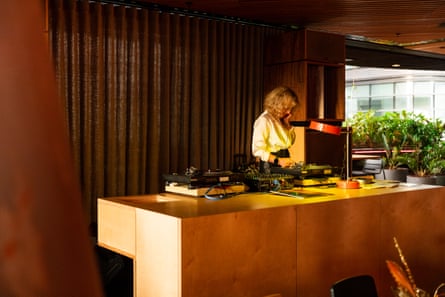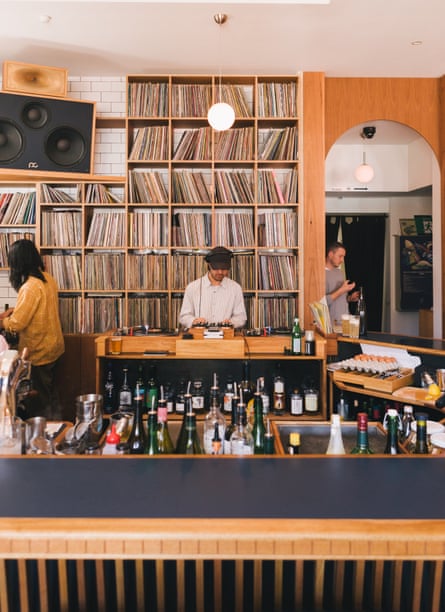
Among the art studios, phở restaurants and noisy pubs of Adelaide’s west end, there is a haven of calm. People gather after work to enjoy some wine, and a few simple snacks, and to be soothed by a carefully selected vinyl record. Nearly is a diligently designed bar that opened in January 2023; the idea was to buy a high-end sound system so co-owner Tom Paxton – a longtime vinyl collector – could bring in a box of records to spin each week.
On a recent visit, classic records by Lauryn Hill, Led Zeppelin and A Tribe Called Quest were in queue for the turntable. At Nearly, music fills the space, complementing the warm colours of local artist Cécile Gariépy’s wine-themed sculptures and paintings. At the curvy-edged tables and bar, South Australian wines are on pour.
Nearly is the latest addition to a wave of bars across Australia that nod to the Japanese cultural phenomenon of jazz kissa, known in English as “listening bars”.
In Australia, these loosely defined spaces share a focus on hi-fi and thoughtful sound placement, alongside careful attention to drinks. It’s a casual approach to music at these spots – unlike the original Japanese jazz kissa, Australia’s listening bars do not expect people to sit quietly to appreciate the music. Instead, these bars integrate their sound systems into a social experience. Swing by early for a quiet chat, or later on for a DJ who might offer a more high-pulse scene.
Sound design is often an afterthought at Australian venues – a 2022 University of Western Sydney study found that over half of participants (many of whom were under 25) “had been severely disturbed by noise” while dining out.
But listening bars show that people crave more careful approaches: to be able to hear the music, hear each other, and to hear themselves think as they drink. At a time when venue playlists are increasingly determined by Spotify algorithms, listening bars also offer an analogue experience: lo-fi drinks such as low-intervention wine, sake or cocktails, paired with hi-fi tunes.
Although they don’t always call themselves listening bars, increasingly it seems that natural-leaning or low-intervention wine bars also have turntables. In Melbourne, Hope St Radio and Public Wine Shop stand alongside Waxflower as the most notable names, with Stem being another Adelaide iteration. LOC in Adelaide loves a guest DJ set. There’s Yakka House, a bottle shop and record store in Wollongong and Franks Wild Years up the highway in Thirroul; Sonny in Hobart; Sydney’s Rekōdo, a Japanese-inspired vinyl bar and restaurant; and Perth’s Astral Weeks, notable for its handbuilt Line Magnetic sound system.

It’s not an accident that low-intervention wines are appearing in vinyl havens. When developing an appreciation for hi-fi sound systems, “over time your ears adjust, much in the same way your palate would adjust to wine gradually,” says Henry Whinney, an audiophile and server at Melbourne’s Public Wine Shop, where a record player complements wine made without any additives whatsoever – the extreme form of natural wine. At a certain point, the ears crave a purity of sound – carried from records on to a needle, via an amp, to vibrational cones within speakers – the same way taste buds would crave a wine made without extra preservatives.
In Sydney, a recent opening in this genre is Ante Bar in Newtown, from Black Market Sake importer Matt Young and his partner, chef Jemma Whiteman. Ante, which opened in 2021, focuses on artisanal, small-batch sakes made with traditional brewing methods.
after newsletter promotion

Young started collecting records as a teenager and now has a collection of about 2,500 titles, some of which can be found organised by genre on the wall of Ante. The sleek space is “more of a bar or restaurant with a serious approach to sound and to vinyl records”, rather than a listening bar, Young says. “We can play the music loud without interrupting people, which is a nice combination.” This ambience was achieved through careful selection and deliberate placement of equipment, with the main components being a sought-after McIntosh amp and speakers from legacy American brand Klipsch. The goal is to ensure the volume is not overpowering, so people can enjoy their food and sake without distraction.
Marek Polgar, co-owner of Waxflower, stresses that the buzzy Brunswick venue isn’t a true jazz kissa in the Japanese sense: “It’s a wine bar with an epic sound system.” Waxflower’s intimate space – where the turntables are actually on the bar – and daytime hours invite natural wine fans to come for lunch while appreciating the handmade Isonoe rotary mixer, which “brings warmth into the sound” of the records they play over bespoke, Tasmanian-made Pitt & Giblin speakers. (Waxflower’s speaker system was actually a Pitt & Giblin prototype that has since become a hallmark offering.)
Listening bars are definitely a global trend: I first noted this phenomenon outside Japan in Paris at Montezuma Café, where alumni of the famed natural wine bar Le Verre Volé have installed one of the world’s most state-of-the-art sound systems in the basement, while upstairs they serve bistro dishes and cult-y bottles. Elsewhere, there’s Los Angeles’ In Sheep’s Clothing; New York’s Eavesdrop; Florence’s wine-and-vinyl shop Vineria Sonora; and London’s Brilliant Corners.
In Japan, Katsumasa Kusunose – founder of Jazz Kissa magazine – says: “[The] first jazz boom began around 1925, and from around that time there were coffee shops that played records on phonographs.” From there, a movement of jazz kissa emerged, mostly serving coffee.

In the postwar era, the jazz kissa saw a resurgence with a new focus on playing vinyl over hi-fi sound systems. “It was a place where you could listen to many of the latest records for the price of a cup of coffee, at a time when records were very expensive and hard to come by,” says Kusunose. In the ‘80s, as Japanese people began installing home audio systems, the jazz kissa movement declined. But it is being revived and according to Kusunose, there are now about 560 known jazz kissa across Japan, a number that is “gradually increasing”.
While Japanese listening bars might discourage people from talking, instead offering a chance for “deep listening”, the new crop of vinyl-focused bars in Australia boasts a refreshing blend of socialising, dining, handcrafted drinks, and an aesthetic and musical experience of the quality that record collectors prefer.
A listening bar provides the atmosphere where you can turn off your phone, tune into your company, and enjoy a fantastic meal or glass of wine (or sake) with a thoughtful setlist: an audiophile’s antidote to the tinny din of laptop playlists.



